|
To some extent we can say the pottery was the forerunner of Chinese porcelain. After the invention of pottery in the Neolithic period, (5000-2200 BC), the ancient Chinese succeeded in producing painted pottery, black pottery and carved pottery. The long time of experience in kiln firing led China entering into a new ceramic age in the Han Dynasty (206 BC-220 AD) although archaeological finds have revealed that glazed pottery was produced as early as the Western Zhou Dynasty (1100-771 BC), yet the production of glazed wares was not common until the Han Dynasty.
An obvious change in the attitude of figure modeling in the Six Dynasties (265-588 AD.) was the inclination to include more details, an effort to make the models look more real. Six Dynasties potters also succeeded in improving the quality of early celadon wares both in glaze color and in body clay. The production of glazed proto-porcelain was a significant achievement in Chinese ceramic history.
During the Tang Dynasty (618 – 907AD), a large number of porcelain wares were in daily use. Chinese patterns on these wares also took on more exotic appeal. The Yue and De kiln of Zhejiang Province had features that were the most popular ones, and another one, Xing kiln in Hebei Province was greatly prized for its white porcelain as 'white like snow'. Kilns baking porcelain for the royalty sprang up producing elegant and dainty works. The major contribution made by Tang dynasty was the production of sancai, or tri-color pottery figurines. Tang pottery figurines comprised three major categories, namely human figures, animals and fabulous tomb guards.
In the Song Dynasty (960 – 1279AD), a variety of genres of porcelain appeared and it became a fashion that people showed great interest in purchasing and collecting certain wares suitable to their tastes. Ru, Ding, Ge, Jun and the official kilns had been the representatives of that age. Official kilns advocated concise patterns of decoration; Ru kiln in Hebei Province added treasured agate into glaze so that the color and texture appeared to be uniquely daintily creamy and could be compared with jade. Henan Province had two famous kilns named Jun and Ding kilns. Since the reign of Emperor Huizong who liked art appreciation, porcelain of Jun kiln was kept exclusively for the royal family. Since the artisans made their porcelain wares separately, there was no repetition among decorative patterns and colors. Thus this made each porcelain product more precious in its own right. Ding kiln boasted its white porcelain which has a texture as delicate as that of ivory with an adornment of black and purple glaze. Distinctive from the other four kilns which stressed color, this one was quite good at engraving and printing flower patterns. While the Ge Kiln produced porcelain articles with various grains and produced an amount of artworks greater than those of the other four.
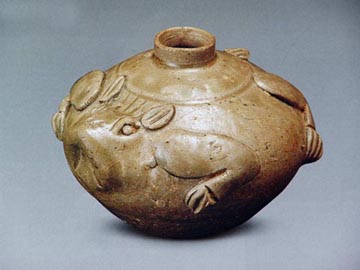 |
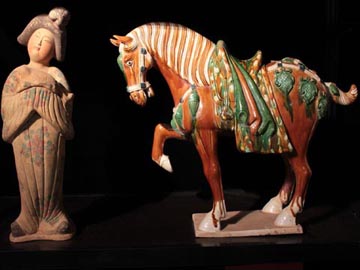 |
Jin
Dynasty Pocelain |
Tang
Tri-color pottery |
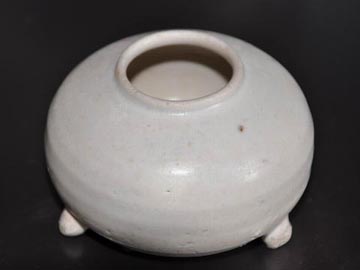 |
 |
White
Porcelain |
Celadon |
 |
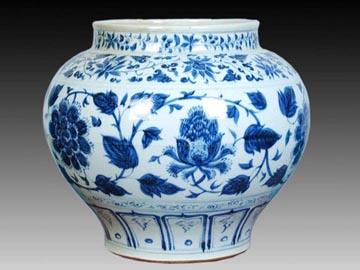 |
Song
Imperial Porcelain |
Blue
and White Porcelain |
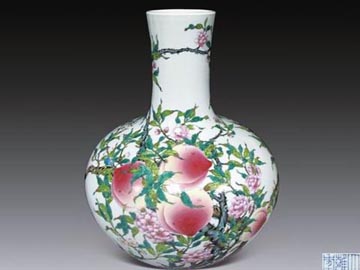 |
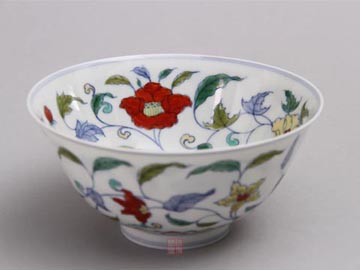 |
Fen
Cai Porcelain |
Dou
Cai Porcelain |
The production of blue and white porcelain appeared at the end of the Yuan dynasty (1279-1368AD). Cobalt was applied in the porcelain industry.
In Yong Le reign (1403-1424), both the potting and glazing techniques improved and wares attained a whiter body and richer blue than those of Yuan dynasty ware. The underglaze blue of the Yong Le wares and Xuan De (1426-1435AD) wares noted for their rich blue tone. Throughout the Ming dynasty, dragon and phoenix were the most popular decorative motifs on ceramic wares. Other animals, plant forms, and human figures in garden and interior setting were often used as decors for blue and white wares. It has been noted that after Wan Li (1573-1620AD), very few ceramic wares of the Ming dynasty bear reign marks.
The fashionable Wucai wares of Jia Jing (1522-1566) and Wan Li (1573-1620) periods are usually fully covered with colorful patterns. Very often the colors are a bit too heavy. The colors used include red, yellow, light and dark green, brown, aubergine and underglaze blue. In Ming dynasty, a variety of porcelain wares were decorated with motifs coming up on colored ground instead. They included wares with green glazed pattern on a yellow ground, yellow glazed pattern on a blue ground, green glazed pattern on a red ground and other color combinations.
Another remarkable category of colored wares produced in the Ming dynasty was the Sancai or 'tri-color'. The major three colors are yellow, green and aubergine. Tri-color wares of the Ming dynasty appeared in the reigns of Xuan De, Jia Jing and Wan Li.
The peak of Chinese ceramic production was seen in the reigns of Kang Xi (1622-1722AD), Yong Zheng (1723-1735AD) and Qian Long (1736-1796AD) of the Qing dynasty during which improvement was seen in almost all ceramic types, including the blue and white wares, polychrome wares, wucai wares, etc. The improved enamel glazes of early Qing dynasty being fired at a higher temperature also acquired a more brilliant look than those of the Ming dynasty. The production of Doucai wares in the Yong zheng period reached new height both in quantity and technical perfection.
The use of Fencai enamel for decorating porcelain wares was first introduced in Kang xi period. The production of fencai enamel wares reached a mature stage in the Yong zheng era. As the improved fencai enamels had a wider range of colors and each could be applied in a variety of tones, they could be used to depict some of the highly complicated pictorial compositions of flower and plant forms, figures and even insects.
When Qing was taken over by the Republic of China (about 1909-1915 AD), the official kilns were closed. In their places, private kilns were established by the operators and artists who previously worked in the official kilns. With their expertise, they produced high quality porcelain wares, such as the 'export porcelain wares made during the transition of Ming to Qing', which earned a high praise in overseas markets, and the excellent imitations of Sung, Yuan and Qing wares are made during "the early stage of the Republic of China," which were almost true to the originals.
After the People’s Republic of China was founded in 1949, social stability led to the renewal of the porcelain industry. The industry has re-gained its previous glory and is enjoying prosperity.
Chinese porcelain is famous for its varied shapes, attracting colors and exquisite workmanship. It has high artistic value and practical function. So it is very welcomed by people from all over the world.
Mobile:(+86-1350 110 3837) Wechat:(13501103837) E-mail: chinasilkrug@msn.com